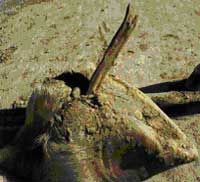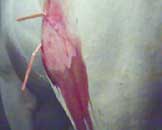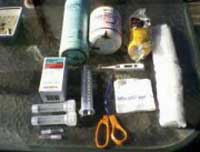|
THE WOUND DILEMMA
Presented by: Wendy Teddiman* |
|
| |
 |
Common Knowledge Information for Equine Care
Common sense is not always common.
After hosing the wound off, indecision hits. Should you call your Veterinarian or is this a wound you can handle yourself? If you decide to handle it yourself, which ointments, powders and treatments are appropriate to ensure proper healing? In this article, I will provide a step-by-step approach for assessing an injury along with advice for first aid kit supplies that you should always have on hand.
I will divide wounds into five categories; Puncture, Foot, Lower-Leg, Upper-Body and Head Wound. Please note that puncture wounds are the only category based on type and merits it's own section, because treatment is universal regardless of puncture location; the other categories focus on wound location because each requires unique treatment.
Each category has it's own flow chart, asking you specific questions regarding your horse's wound. Your "yes" or "no" answers will tell you whether or not to call your Vet. If the injury meets the criteria for "home treatment", I'll outline the steps you need to take. If veterinary attention is indicated, I'll tell you what to expect when your vet arrives.
Volume 1: Issue 2 - When To Call The Vet / When To Treat It Yourself
Volume 1: Issue 3 - Puncture Wounds
Volume 1: Issue 4 - Upper Body Wounds
*Wendy has written a series of articles sharing her knowledge of common things you should know about caring for your horse. Including many basic facts to help you identify when your horse is in distress, what the potential distress may be caused by and when you should call your veterinarian for additional professional treatment.
Please note: This is not a replacement for your veterinarian!
When in doubt about your horse's physical condition, CALL YOUR VET. |
|
Upper Body Wounds
Volume 1: Issue 4 |
 |
Upper body wounds include everything from your horse’s poll to his tail, and his upper legs as well. These are commonly caused by bites and kicks from pasture-mates. They can also be caused by a variety of objects found around the barn, such as stall doors, tractors or other vehicles, arena fencing, jumps, and “road rash”, just to mention a few.
Even though some of these wounds can be large and ugly, with torn skin, and muscle damage, the good news is that most of the time they heal with very little scarring, and very rarely any problem with proud flesh. Even wounds left unsutured may heal fairly well. One of the reasons for this is that they are not subjected to the same degree of movement, as in other areas of the body. |
FLOW CHART
1) Can you see muscle damage with exposed blood vessels or other vital organs?
Answer: YES ~~ CALL YOUR VET
Answer: NO ~~ Go to Question 2
2)Is there swelling, or a pus-like discharge, indicating a possible infection? (may or may not be accompanied with a fever)
Answer: YES ~~ CALL YOUR VET
Answer: NO ~~ Go to Question 3
3) Is it a full thickness skin wound (the edges can be easily pulled apart), or is there a large, loose flap of skin?
Answer: YES ~~ CALL YOUR VET
Answer: NO ~~ Go to Question 4
4) Will your horse allow you to treat the wound?
Answer: YES ~~ Apply Home Treatment
To Apply Home Treatment
- Clean the wound thoroughly with a gentle stream of cold water for about 15 to 20 minutes. This will also help to reduce any swelling, or inflammation. Then, flush the entire wound several times with a dilute Betadine/water solution, using a 30 to 60 cc syringe.
- Flush daily, until you can see that the wound has filled in with new tissue.
- Each day, after flushing the wound, apply triple antibiotic ointment. Furacine or Biozide Gel can also be used if you do not have the triple antibiotic ointment, as upper body wounds are less likely to develop complications, inherent to lower leg or foot wounds.
- Give your horse 1 gram of Bute twice a day (or 2 grams once a day, depending on your schedule) for five to seven days. This will help to reduce the inflammation and swelling.
If your horse develops signs of an infection (see flow chart)..
Call your vet immediately!!
What To Expect If You Call Your Vet
Your Vet...
~Will clean the wound and possibly block the area with a local anesthetic, if he determines that suturing the skin and any torn underlying muscle is necessary.
~May suture a rubber “drain” into the wound. If the wound involves a large amount of muscle damage, this will encourage the wound to “drain” out any excess fluids caused by the healing process. This is also a precautionary measure, in the event of infection, to allow the wound to continue draining freely.
~Will give you specific after care instructions, which may include flushing the wound daily with an antiseptic solution.
~May prescribe antibiotics and bute.
You can expect your vet to remove the sutures in about 10 to 14 days, barring any unforeseen complications, such as infection, or sutures being torn/pulled apart. |
|
Puncture Wounds
Volume 1: Issue 3 |
 |
Puncture wounds are deep penetrating holes caused by close encounters with sharp objects, such as nails or wire. Even a small entry wound can be severe because of the dirt and bacteria being driven deep into the tissue by the offending sharp object. If a puncture wound is not treated properly, the onset of infection can occur rapidly. The tetanus bacterium is a prime example. Being that it thrives in an anaerobic environment.one lacking oxygen.it would find the depths of a puncture wound particularly inviting.
Puncture wounds are not limited to impalement injuries. A blunt-trauma injury, such as a kick from another horse, can result in a puncture-type wound. The blow may produce a small surface wound, but the pressure can cause a deep tract to form in the tissuesbelow and can only be detected by probing the wound's opening. Such a wound should be treated as a puncture as long as a more serious underlying injury, such as a fracture, hasn't occurred. (Note: If your horse steps on a nail, refer to the "Foot Wounds" section) |
FLOW CHART
1) Is the puncture wound near enough to a joint to have entered the joint cavity? (If so, you'll see "bubbly" yellow joint fluid seeping from it)
Answer: YES ~~ CALL YOUR VET
Answer: NO ~~ Go to Question 2
2) Is excessive swelling, heat, or a puss-like discharge present?
Answer: YES ~~ CALL YOUR VET
Answer: NO ~~ Go to Question 3
3) Does your horse have a fever (over 102 degrees) indicating a possible infection?
Answer: YES ~~ CALL YOUR VET
Answer: NO ~~ Go to Question 4
4) Is the puncture wound on an extremity?
Answer: YES ~~ CALL YOUR VET
Answer: NO ~~ Go to Question 5
5) Does it appear as though a foreign body, such as a nail, is present in the wound?
Answer: YES ~~ CALL YOUR VET
Answer: NO ~~ Go to Question 6
6) Will your horse allow you to treat the wound?
Answer: YES ~~ Apply Home Treatment
Answer: NO ~~ CALL YOUR VET
To Apply Home Treatment
- Probe the wound with a clean "teat cannula" (long thin tipped tube you can get from your vet) to determine if there is an underlying tract. If so, attach a 30 to 60 cc syringe to the "teat cannula" and flush the wound with a dilute Betadine/water solution (one part Betadine to 20 parts water and appearing as the color of weak tea). This will provide antibacterial protection.
- Continue flushing the wound until the fluid coming out of the wound is as clear as the fluid going in. No antibiotic ointment is necessary to a puncture wound because the wound's inner recesses aren't exposed to air and dirt (and it gains antibacterial protection from the Betadine solution).
- Check your horse's tetanus-immunization status and take appropriate measures.
- Flush the wound daily to prevent infection and allow for healing from the inside out. During this process you may need to remove the scab and it may become increasingly difficult to insert the teat cannula. You need to persevere and continue flushing until the hole has completely healed up to the skin's surface.
- If the wound is draining, serum build up can cause skin sores. Smear Vaseline on the skin beneath the wound to prevent such a build up.
- Give your horse 1 gram (1,000 milligrams) of Phenylbutazone ("bute") twice daily (or 2 grams once a day if that is all your schedule allows) for approximately five days. This will reduce inflammation and minimize swelling.
If your horse develops signs of an infection (see flow chart)..
Call your vet immediately!!
What To Expect If You Call Your Vet
Your Vet...
~Will probe the wound to determine the depth and severity. If it appears to be an uncomplicated puncture, (not involving bone, joint or tendon sheath) he will flush it out with an antiseptic solution, such as Betadine and water.
~May collect a joint fluid sample to check for signs of an infection if the injury is near a joint. If joint involvement is suspected, he may also flush the joint.
~May x-ray the wound area to determine a treatment course if a foreign body or extensive damage is suspected.
~May infuse antibiotic ointment into the wound to help prevent/treat infection.
~May prescribe systemic antibiotics, in the form of pills or injections to help stave off infection; he may also prescribe non-steroidal anti-inflammatory drugs, such as Bute or Banimine, to help reduce inflammation and swelling.
~Will evaluate your horse's tetanus-immunization status and take appropriate measures.
Most uncomplicated puncture wounds respond well to treatment and you can expect your horse to heal in a week to 10 days. |
|
When To Call The Vet - When To Treat It Yourself
Volume 1: Issue 2 |
So Let's begin with Wound Basics
Below are five rules to follow when assessing an injury to your horse. This will also be helpful information to provide your Vet, if you do need to call him out.
1) Examine your whole horse. When you discover your horse is injured, you will be tempted to focus on the first wound you see, which could cause you to miss another major problem. Take a moment to step back and perform the following evaluation:
• Is he showing signs of shock? A rapid heartbeat (greater than 80 beats per minute), respiratory rate (over 30 breaths per minute), sweating or cold ears and lower legs
• Examine your horse from head to toe. Is he suffering from more than one wound? If so, evaluate each one using the flow chart I will be providing in next week's article.
• Could colic have caused him to injure himself? Observe your horse's behavior for signs of discomfort, breaking out in patchy sweat, looking at his belly, trying to lie down or trying to roll.
2) Evaluate the bleeding. Your horse may bleed a lot---but how much is too much? While in most cases, the bleeding you see won't be life-threatening, excessive bleeding can be. Here's how to determine what is excessive and what to do until the Vet arrives.
If bleeding is profuse, bright red, or pulsating, he could have severed an artery and could bleed to death. Apply a direct pressure wrap over the wound opening with anything you have at hand to stop the flow of blood---and have someone call your vet immediately.
If the blood is dark red, your horse is bleeding from a vein, which is slower, and responds well to direct pressure. Your horse is less likely to bleed to death. However, if bleeding is profuse, call your Vet immediately.
3) Protect against tetanus. Because the tetanus bacterium is everywhere, be sure to keep your horse's vaccinations up to date. Know your horse's vaccination status. If he's never been vaccinated (or not in the last three months) he will need a tetanus booster vaccine, which will give him enough protection to get him through the healing process.
4) Avoid overkill. If you determine that this is a wound for veterinarian attention, avoid applying any ointments, sprays or powders, which could impede suturing efforts. Instead, hose the wound with a gentle spray of cold water. This will reduce
|
inflammation, clean the wound, and not damage sensitive tissues. If you can manage the wound yourself, avoid any preparations labelled as "caustic wound dressings", as they can be quite damaging to healthy tissue.
5) A stitch in time… You should call your vet immediately for any fresh wound you believe needs suturing. An appropriately treated wound up to several weeks old can still be sutured successfully but keep in mind the sooner, the better. The longer you wait, the more you run the risk of having secondary issues to deal with, including infection, which will need to be treated with antibiotics before suturing can take place. |
 Hip wound with Sutures & Drain
Hip wound with Sutures & Drain |
Click here for some basic facts such as body temperature, heart and respiratory rates that you should know about your horse's health in a healthy state.
ALWAYS REMEMBER…WHEN IN DOUBT….CALL YOUR VET! |
WOUND FIRST-AID KIT
Betadine (in a clean container, mix one part Betadine with twenty parts water for an antiseptic flushing solution)
Large needless syringe (30 or 60 cc)
A long blunt ended needle with which to probe wounds, and to attach to a syringe for flushing injury site “a teat canula”
Triple-antibiotic ointment
Non-steroidal eye ointment
Furacine, or providone-iodine-based ointment
Pressure wrap materials
Phenylbutazone ("bute") powder or paste
Keep your first-aid kit up-to-date at all times, and make sure you keep it in an easily accessible place. |

First Aid Kit |
|
*Wendy has a very extensive and varied history in the horse trade that extends beyond State and Country borders. With a love of horses that stems from childhood, Wendy has worked in Canada (Ontario & British Columbia) and the United States (West Virginia & California). This included working at numerous race tracks (Canada and United States) in capacities such as Veterinary Technician and assisting in equine surgeries. She is also skilled at recognizing lameness issues, and how to both treat and prevent them. In addition to her Canadian education, Wendy graduated from the Equine Program at Meredith Manor, West Virginia.
Wendy has been actively providing training and rehabilitation services in the San Juan Capistrano area for over 15 years now and has recently made the decision to share her expertise from her many years of experience by way of writing. Over the years, Wendy has observed that "common sense" is not always "common" and this resulted in her using what she calls an "uncommon-sense" approach .
To get to know more about Wendy Teddiman, visit www.wen-d-acres.com |
|
|
| |
|
| |
|
|